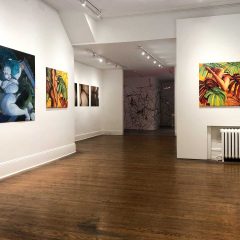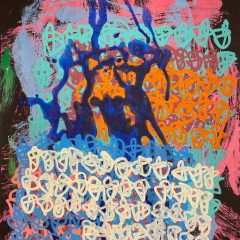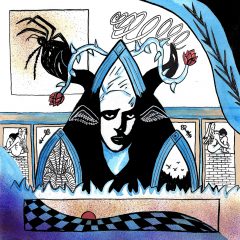When Chelsey Luster reached out to me about seeing her latest curatorial project, 19.5%: Women in Power & Politics, I was not familiar with her work nor the work of most of the 16 artists featured. (Autumn Wallace, whom I learned about via Artblog, was the sole exception.) However, the apprehensive part of my brain still imagined the ways the show, or any visual exhibition, would fail to address the complexities of gender and politics.
What I saw however, amazed me. Chelsey Luster has crafted an exhibition that could confound the most binaristic thinker, an impressive feat for an art show on two divisive topics. She does this through a rather skillful curation, the kind that reminds us why the profession exists in the first place. In the space between language and truth is aesthetics, Luster utilizes politics as a frame to emphasize the need for new and empathetic understandings of who we really are.
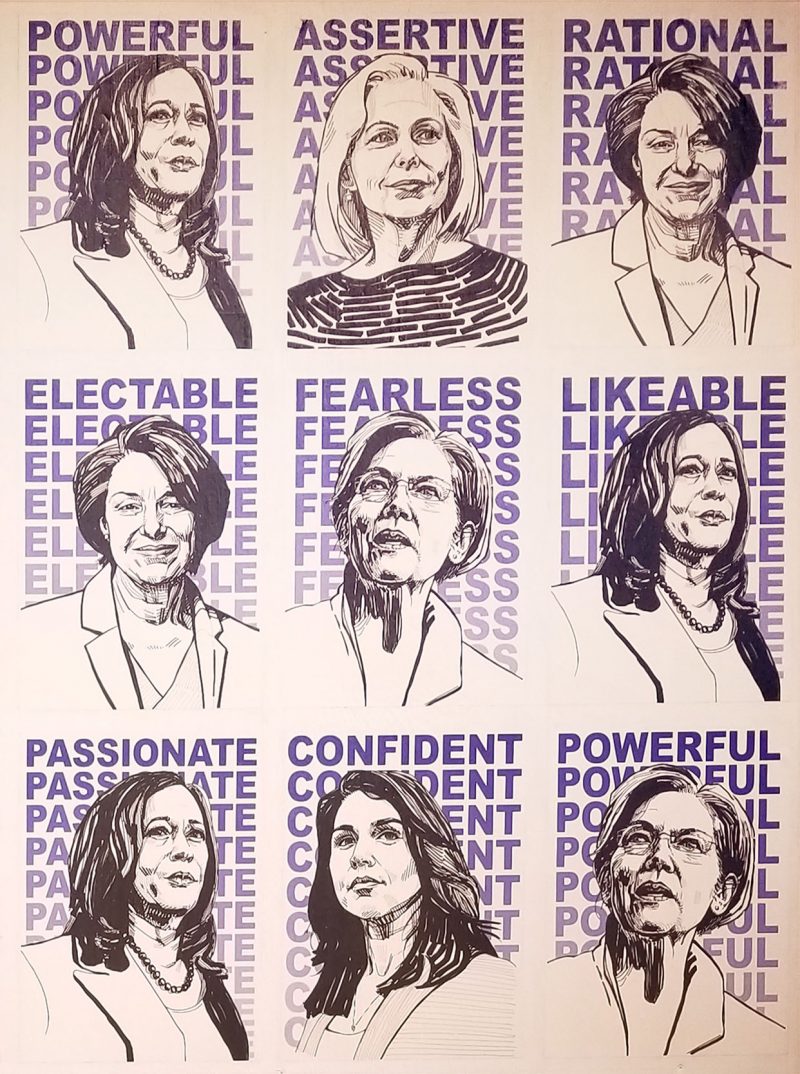
Of the 16 works in the show only one overtly references current American politics. Hysterical Men’s “Electable” opens up the show. Hysterical Men (a singular artist) has made 20 prints that contain black-and-white drawings of the women currently running for President. Behind each of their heads is a single repeating word, printed in deep blue ink. There are 20 prints—which are mounted on a tall wood panel—that rotate through 5 candidates and various words: electable, powerful, assertive, likeable, fearless, authoritative, passionate, strong.
“Electable” pushes against the misogyny that often prevents us from attributing positive leadership traits to women. The inability to assign positive language to women—to the feminine and girly—is both the result and perpetuator of the devalued experiences of women, as well as other marginalized genders.
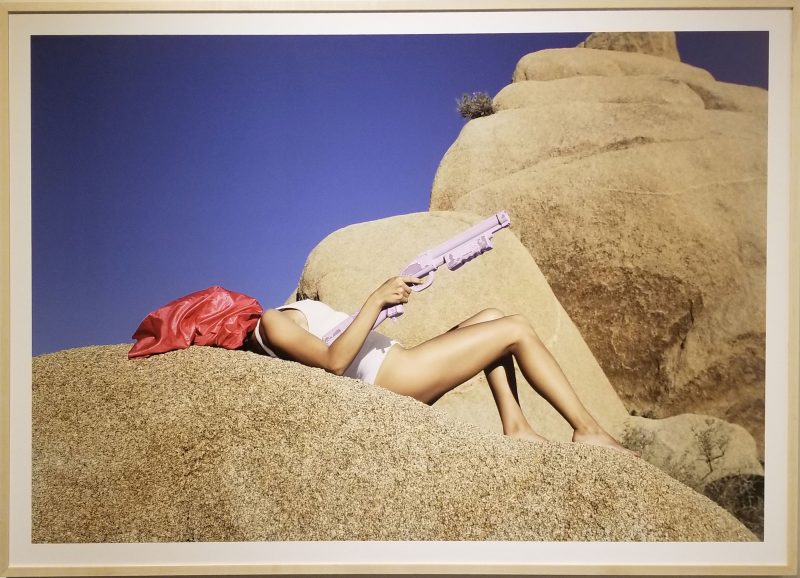
Unlike “Electable”’s use of language to convey message, “Ladies Ladies Ladies,” a large photograph by Annalise Yuri Murphy deals with guns, and by implication, violence, in a powerful but silent image. In it, a bare-legged woman lies back atop a large sedimentary boulder. Surrounding her are other towering stones and a clear blue sky. Her head completely covered by a red fabric, which splays slightly onto the rock below. Idly as she lays, the figure holds a lavender rifle and points it blindly into the air. The photo is a collage of textures and tensions; the rough rock, smooth skin, shiny fabric, femininity, violence, and nature.
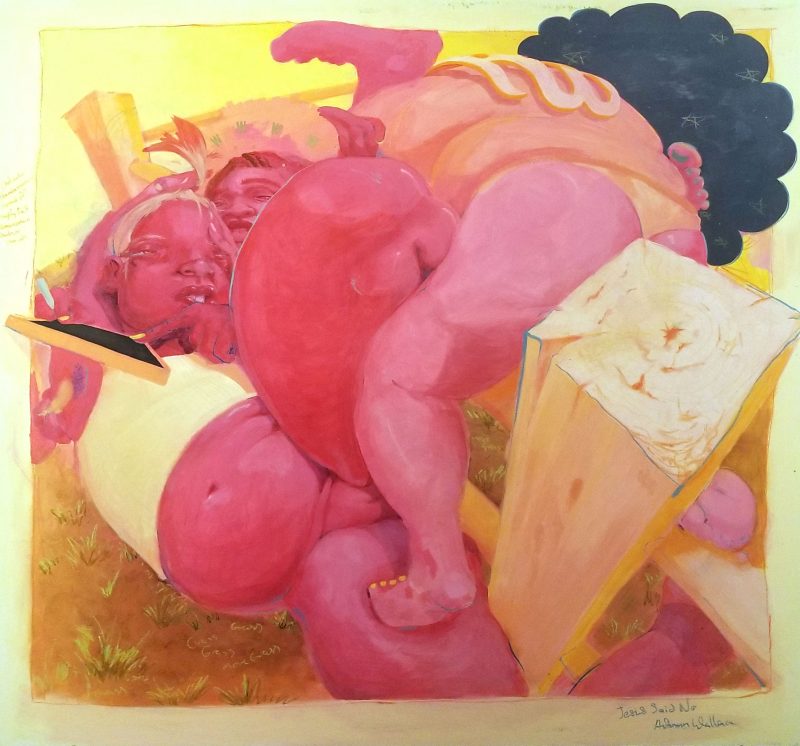
If “Ladies” treats its subject directly, Autumn Wallace’s painting, “J-sus Said No” plays with the complexity of representing a body, in a work whose atmosphere is sexualized yet meaning is unclear. The painting contains the contorting forms of two (or perhaps three?) bulbous and magenta figures. The figures weave through a wooden fence—which initially registered as a bedpost to me—and with neutral, veering on sedated, expressions. Whether the subjects are sexual, playful or in a state of apathy likely depends on the viewer.
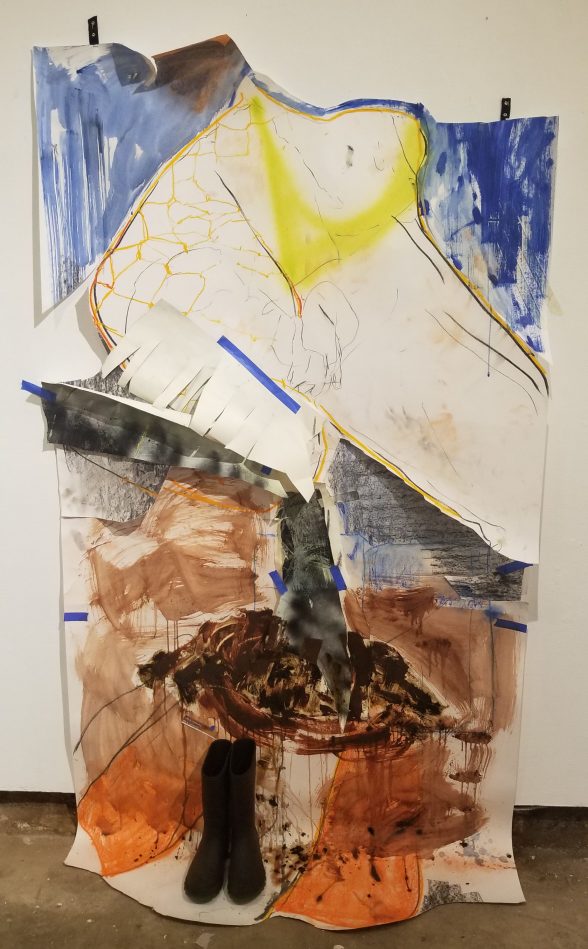
Chloe Pinero’s “Mound,” a piece which intrigued me most out of the show, is a towering mixed media collage, assembled primarily with paper and paint. As a formal work Pinero’s piece is muralesque in it’s confident composition across such a large space and fluctuates between broad paint strokes, the detailed textures of charcoal and coffee grounds, and large sections of dangling cut paper. Upon further reading, Pinero describes these elements as representations of the recovery in Puerto Rico after Hurricane Maria. “Mound” inspires ideas around the use of paper, a highly temporal material for sculpture, when memorializing moments of transition.
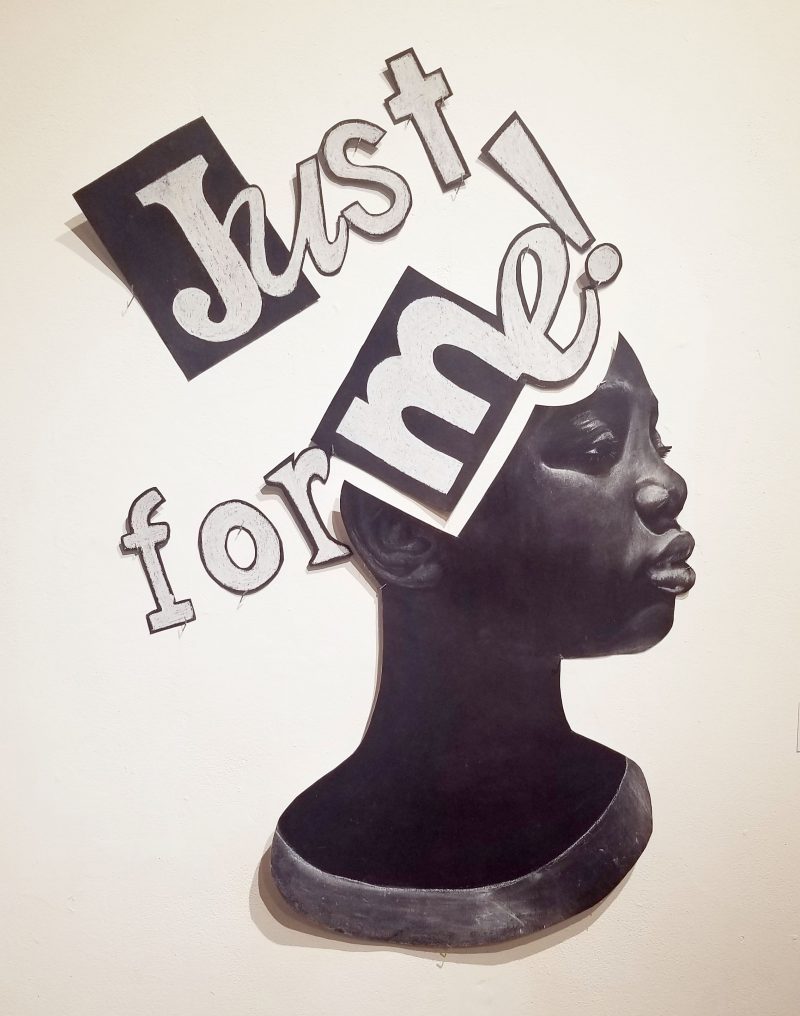
Self-portraits hold a particularly empathetic power in the show. Gabe Loredo’s “Revuelta” is an intricately and fantastical drawing of Loredo existing in various states of self. They’ve depicted themselves with four arms which allows for more symbols and facets of identity; one holds a lighter, another is raised high with a molotov cocktail, and two are posed under Loredo’s chin. These two arms are exposed so we can revel in Loredo’s brown skin, hairy arms and painted nails. Their splayed fingers accentuate the bloom of flowers from their shoulder. “Subjective Portrait (Just For Me)” is a cut and collaged drawing installed onto Little Berlin’s walls. Chris Friday’s self-portrait features herself in profile, looking off with a heavy expression. Her hair has been cut out and in its place are the large words, “Just For Me!” which is the name of a chemical hair relaxer for young girls. The bouncing letters replicate its iconic design.
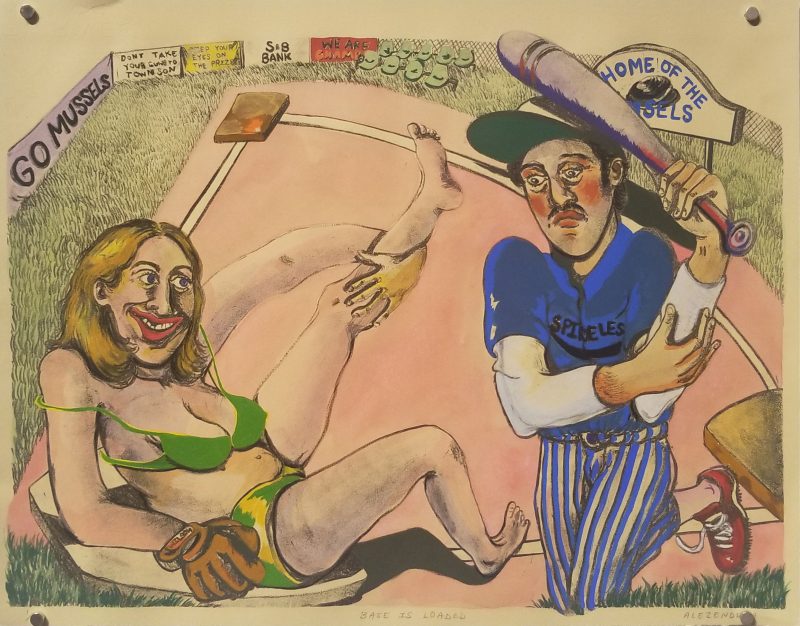
Alezendria Decking and Jacquieline White created pieces dealing with the overtly sexual. Decking’s comical drawing, “Bases Are Loaded” takes place on a baseball diamond and depicts an underwear clad woman wearing a catcher’s mitt, stretching out her legs invitingly to a baseball player who looks down at her dejectedly. She meets his gaze with a bright smile. “Baby Got a New Fur Coat” by White features a pair of breasts painted squarely onto canvas and then covered by the edges of what alludes to be a fur coat through strips of fabric placed on the edges of the canvas. There is also a necklace attached which plummets right into the middle of the figures cleavage. This piece initially excited me for it’s straight-forward depiction of a sexual body and how it challenged my gaze and ability to critical articulate what I was seeing. However reading that the piece was a critique of this sexuality and hoped “to demean these constructs as out-dated and relieve the path for future womxn in politics” was extremely disappointing. (Perhaps it can live on as a critique of its own critique?)
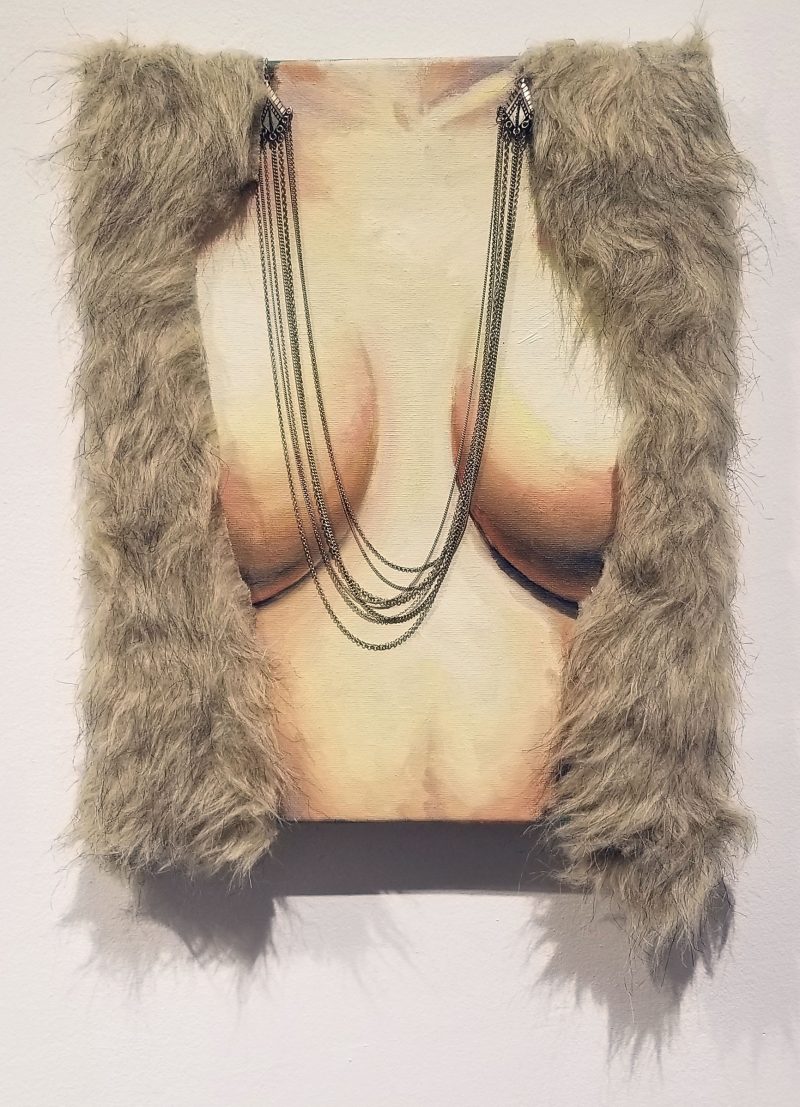
19.5% reminded me how much women are controlled by a network of inarticulations. There is a lack of language around feminine selfhood; emotions, anatomy, pleasure, trauma, anger, joy. Kelley Prevard, Shelby Flemming, Jessica S. Oler, Gerald Brown, Nikki D’Agostino, Alfiatul Nurdin, Gabe Loredo and Lucy H. West, as well as the aforementioned artists, contribute pieces that vibrate with the personal.
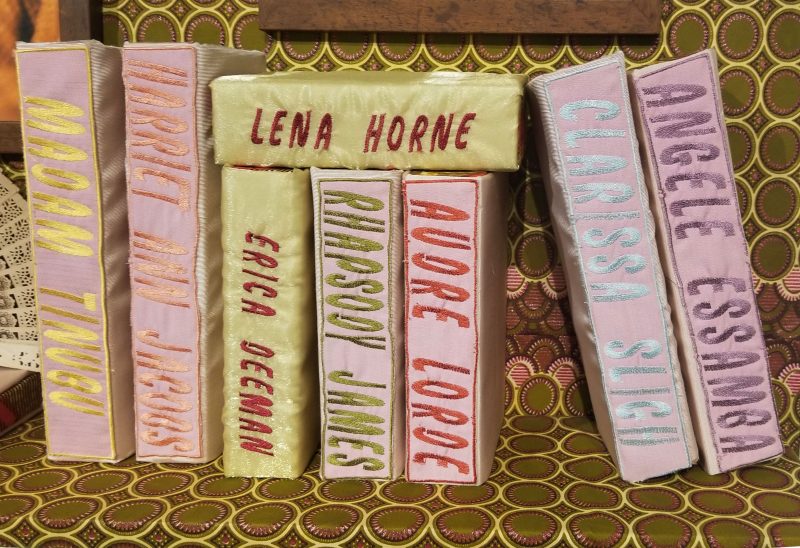
Chelsey Luster has curated an exhibition that fills in some of the cracks between how we think and what we feel. The summation of this intention is given by an installation by Francena Ottley, “The Rewrite.” Mounted onto the wall is what appears to be a well manicured, if not fantastical, slice of a living room; wall paper, beautiful portraits of black womxn and a bookshelves filled with soft and pink replications of books. Each spine holds a name of an impactful black woman: Angela Davis, Misty Copeland, Assata Shakur, Rosa Parks, Ava Duvernay, Marita Bonner. There are perhaps 100 or so books on display. Although there is nothing to read in these “books” the symbol of a book as a holder of knowledge, culture, and connection to our histories is illuminated. We crave more learning and the tools are already here.
A closing reception and panel discussion for 19.5% takes place Saturday, Sept. 28, at Little Berlin from 7-9 pm. Little Berlin, 2430 Coral St, Philadelphia, PA 19125.


